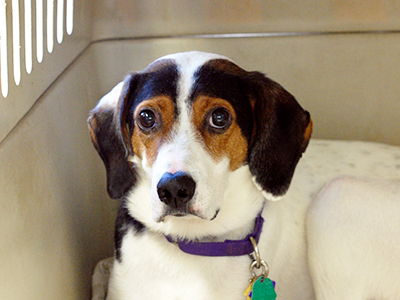 Crate training is one of the most effective ways to help your pet learn good behavior while keeping them safe. Whether you’ve welcomed a new puppy or adopted an adult dog, a crate can be a valuable tool to set your pet up for success, and with the right approach, crates can become a cozy, safe space for your pet.
Crate training is one of the most effective ways to help your pet learn good behavior while keeping them safe. Whether you’ve welcomed a new puppy or adopted an adult dog, a crate can be a valuable tool to set your pet up for success, and with the right approach, crates can become a cozy, safe space for your pet.
For dogs in particular, crate training helps teach independence and can prevent separation anxiety later in life. It also creates a safe, familiar space when traveling or visiting new places. A well-trained dog will feel calm and secure in their crate, whether at home, on the road, or at the vet.
Your dog’s crate should be just large enough for them to stand up and turn around in. If your dog is still growing, choose a crate that will accommodate their adult size. Crate training can take days or even weeks, depending on your dog’s age, temperament, and past experiences.
It’s important to keep two things in mind while crate training. 1: The crate should always be associated with something pleasant. 2: Training should take place in a series of small steps. Don’t go too fast.
Step 1: Introducing Your Dog to the Crate
- Place the crate in a popular area of your house, such as the family room.
- Make the space inviting. Put a soft blanket or towel in the crate. Bring your dog over to the crate and talk to them in a happy tone of voice. Make sure the crate door is open and secured so that it won’t hit or frighten your dog.
- Encourage your dog to enter the crate. Place small food treats nearby, then just inside the door, and finally, all the way inside the crate. If they refuse to go all the way in at first, that’s okay; don’t force them to enter. Once in the crate, start by giving treats in rapid succession, quickly enough to keep him inside. Then slow the rate so they learn to wait in the crate for 3-5 seconds between treats. If they aren’t interested in treats, try tossing a favorite toy in the crate. This step may take a few minutes or as long as several days.
Step 2: Meals Near the Crate
After introducing your dog to the crate, begin feeding them their regular meals near it, creating a pleasant association.
- If your dog is readily entering the crate when you begin Step 2, place the food dish at the back of the crate.
- If your dog remains reluctant to enter the crate, put the dish only as far inside as they will readily go without becoming fearful or anxious.
Each time you feed them, place the dish a little further back in the crate. Once your dog stands comfortably in the crate to eat their meal, you can close the door while they eat. The first time you do this, open the door as soon as they finish their meal. With each successive feeding, leave the door closed a few minutes longer, until he’s staying in the crate for 10 minutes or so after eating.
Vocalization in the kennel: If they begin to whine to be let out, you may have increased the length of time too quickly. If they whine or cry slightly in the crate, wait until they stop, then let them out. Dogs who vocalize in the crate should be rewarded intermittently for being calm and quiet instead. When your dog can be in the kennel without whining, proceed with the following steps.
Step 3: Conditioning Your Dog to the Crate for Longer Periods
After your dog is eating their regular meals in the crate with no sign of fear or anxiety, begin to confine them for short periods while you’re home. Call them over to the crate and give them a treat. Give them a command to enter, such as “kennel.” Encourage them by pointing to the inside of the crate with a treat in your hand. After your dog enters the crate, give them the treat and close the door. Sit quietly near the crate for five to ten minutes and then go into another room for a few minutes. Return for a short time, then let them out of the crate. Repeat this process several times a day.
With each repetition, gradually increase the length of time you leave them in the crate and the length of time you’re out of their sight. Once your dog stays quietly in the crate for about 30 minutes with you out of sight, the majority of the time, you can begin leaving them crated when you’re gone for short periods or letting them sleep there at night. This may take several days or several weeks.
Step 4:
A) Crating Your Dog When Left Alone
After your dog can spend about 30 minutes in the crate without becoming anxious or afraid, begin leaving them crated for short periods when you leave the house:
- Put them in the crate using your regular command and a treat. You might also want to leave them with a few safe toys in the crate, blankets, and other items to help them feel safe.
- Vary what point in your routine you put your dog in the crate as you prepare to leave. Although they shouldn’t be crated for a long time before you leave, you can crate them anywhere from 5 to 20 minutes prior to leaving.
- Don’t make your departures emotional. Praise your dog briefly, give them a treat for entering the crate, and then leave quietly.
- Don’t over-excite your arrivals. Dogs will view your excited behavior as a reward and respond in an excited, enthusiastic way. Keep arrivals low-key to avoid increasing their anxiety.
Continue to crate your dog for short periods from time to time when you’re home so they don’t associate crating with being left alone.
B) Crating Your Dog at Night
Put your dog in the crate using your regular command and a treat. Initially, it may be a good idea to put the crate in your bedroom or nearby in a hallway, especially if you have a puppy. Puppies often need to go outside during the night, and you’ll want to be able to hear your puppy when they whine to be let outside. Older dogs, too, should initially be kept nearby so that they don’t associate the crate with social isolation. Once your dog is sleeping comfortably through the night with their crate near you, you can begin to gradually move it to the location you prefer, although time spent with your dog, even sleep time, is a chance to strengthen the bond between you and your pet.
Potential Problems
Too Much Time in the Crate
A crate isn’t a magical solution. If not used correctly, a dog can feel trapped and frustrated.
- If your dog is crated all day while you’re at work and then crated again all night, they are spending too much time in too small a space. Other arrangements should be made to meet their physical and emotional needs.
- Puppies under six months of age shouldn’t stay in a crate for more than three or four hours at a time. They can’t control their bladders and bowels for longer periods.
Whining
If your dog whines or cries while in the crate at night, it may be difficult to determine whether he’s whining to be let out of the crate or whether they needs to be let outside to use the bathroom.
If you’ve followed the training procedures outlined above, your dog hasn’t been rewarded for whining in the past by being released from their crate. If that is the case, try to ignore the whining. If your dog is just testing you, he’ll probably stop whining soon. Yelling at them or pounding on the crate will only make things worse.
If the whining persists after ignoring them for several minutes, use the phrase they associate with going outside. If they respond and become excited, take them outside. This should be a trip with a purpose, not playtime.
If you’re convinced that your dog doesn’t need to use the bathroom, the best response is to ignore them until they stop whining. Don’t give in, as this teaches your dog to whine loudly and long to get what they want. If you’ve progressed gradually through the training steps and haven’t gone too fast, you’ll be less likely to encounter this problem. If the problem becomes unmanageable, you may need to start the crate training process over again.
Separation Problems
Attempting to use the crate as a remedy for separation anxiety won’t solve the problem. A crate may prevent your dog from being destructive, but they may injure themselves in an attempt to escape. Separation problems can only be resolved with counter-conditioning and desensitization procedures. If you believe your dog is experiencing separation issues, it is advisable to consult a professional animal behaviour specialist.
Adapted from material originally developed by applied animal behaviourists at the Dumb Friends League, Denver, Colorado.
©2000 Dumb Friends League and ©2003 The HSUS. All rights reserved.
Promoting the Protection of All Animals
Adapted from Low Stress Handling, Restraint and Behavior Modification of Dogs and Cats by Dr. Sophia Yin. (www.nerdbook.com)



